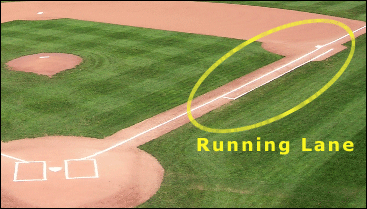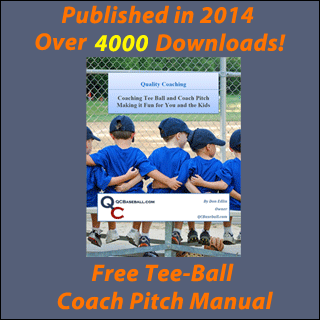Running Lane to First Base
A rule that I occasionally get asked about occurs when a batter/runner is running to first base and either gets called out for interference (and maybe shouldn't have been) or not called out for interference (and maybe should have). This could either be because he was hit with a thrown ball (usually from the catcher or pitcher on a bunt) or if there is contact with the first baseman.
 The hardest part of this for the player is that first base is in fair territory and the batter/runner is supposed to run to first base in the running lane which is not in fair territory. A right handed batter can easily and will often run out a ground ball and never run in the running lane that is chalked 45 feet down the line. The majority of the time this isn't an issue as interference won't be called simply because a player is not running in the running lane.
The hardest part of this for the player is that first base is in fair territory and the batter/runner is supposed to run to first base in the running lane which is not in fair territory. A right handed batter can easily and will often run out a ground ball and never run in the running lane that is chalked 45 feet down the line. The majority of the time this isn't an issue as interference won't be called simply because a player is not running in the running lane.
Rule 6.05 (k) covers this rule and is (from the Major League Rulebook):
Of course there is always going to be controversy because the enforcement of the rule is based on the umpire's judgment. I think the easiest way to gain an understanding of the rule is to go over some situations where the rule comes into play.
Dropped third strike or bunt where the thrown ball hits the runner on his way to first
- Runner runs to first running inside the running lane and is hit with the ball before touching first base.
Correct call: runner is safe - Runner runs to first running outside the running lane and is hit with the ball before touching first base.
Correct call: runner is out
(So far, so good, fairly straight forward in those two situations.)
- Fielder sees that the runner is running out of the running lane and is in the way of the throw, so he holds the ball and doesn't make the throw.
Correct call: runner is safe
Explanation: In the rule you'll notice that interference is "with the fielder taking the throw at first base". So if there is no throw, then there is no interference. - Runner runs to first running inside the running lane and is hit with the ball before touching first base on his last step as he moves over to touch first base.
Correct call: runner is safe
Explanation: The runner is allowed to move over out of the running lane to touch first base and clearly if he is moving over at the end of the running lane, his intent is to touch first base and not interfere with the throw. - First baseman sets up in foul territory to receive the throw from the catcher on a dropped third strike. Runner runs to first running outside the running lane (to the left in fair territory) and is hit with the ball before touching first base.
Correct call: runner is safe
Explanation: The runner is allowed to exit the running lane in order avoid a fielder, which in this case is a first baseman who is standing directly in the running lane. Since the runner is running to the left of the running lane he is not intentionally trying to interfere with the throw or the first baseman and should be called safe. - First baseman sets up in foul territory to receive the throw from the catcher on a dropped third strike. Runner runs to first running outside the running lane (to the left in fair territory) and then moves into the running lane and is hit with the ball before touching first base.
Correct call: runner is safe
Explanation: If in the judgment of the umpire, the runner made an "egregious" move where it is obvious that he is deliberately trying to be hit by the ball or interfering with the first baseman's ability to catch the ball, then the runner should be called out. But the runner is protected by the running lane and that move alone to get back in the running lane should not be construed as "intent".
Hopefully that gives you a good idea of the rule and how it applies to different situations. A runner can also be called out for interference by making contact or interfering with the first baseman's ability to field the thrown ball. So in the previous example if the runner is running in the running lane and runs into the first baseman or interferes with his ability to catch the ball, the runner should be called out even though he is in the running lane. Just as you are not automatically out by running outside the running lane, you're not automatically safe by running in the running lane. The umpire needs to judge where the runner is intentionally interfering or not and then make the call based on that.
Most Recent Blog Posts
Working With Players on Focusing on the Correct Part of the Baseball when Hitting (October 15 2016)
Getting More Accurate Throws From Your Team (April 5 2016)
I simply want to thank you for starting this site. I love the experiences you have shared and they really hit home to me. Please keep up the great work.
- Jeremy C.







